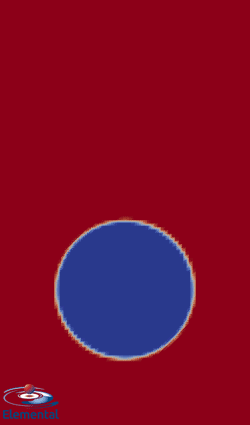During the final stage of launch a space vehicle must be able to accurately control its trajectory if it is to put its payload in a stable orbit. Ability to accurately predict the loads from the propellant in the fuel tanks is thus critical for control and thruster design. Additionally, modelling of propellant in satellite fuel tanks enables better lifetime prediction and therefore better cost efficiency. In micro-gravity environments, fluid behaviour is dominated by phenomena such as surface tension and evaporation. Using a volume-of-fluids two phase model, the aim of the project is to accurately and model the aforementioned phenomena. In this regard both an accurate physical model and adaptive meshing technique is to be researched it create a state-of-the-art micro-gravity slosh model.
Surface modelling for arbitrary meshes - Bevan Jones
Bevan Jones's project focuses of on the modelling and capturing of free surface effects. Limitation with standard Volume-of-Fluid modelling of surface effects arise due to the smearing of the free surface over several computational cells. To capturing the effects the surface must first be reconstruction via the underlying volume fraction field. The accuracy of such reconstruction is critical to the accurate capturing of interface phenomena. For example, even slight numerical errors can result in surface tension calculations generating artificial velocities around an initially static bubble. While many have worked to reduce these and other related problems the approaches taken are suited for structured meshes only. For this project new numerical models are to be developed which can provide high accuracy on unstructured meshes.


ALE for free-surface modelling in micro-gravity - Niran Ilangakoon
Since the dominant physics occurs at the free-surface of the liquid, computational meshes that are sufficiently refined to capture the phenomena near the free-surface are necessary. However, refinement of elements in a static mesh leads to prohibitively small time-step sizes in the simulation, which leads to a significant increase in the simulation time. These restrictions can be overcome by utilising what is known as an Arbitrary Lagrangian-Eulerian (ALE) description of the governing mathematical equations. ALE allows the governing equations to be interpreted in a manner that accommodates for the motion of the computational mesh relative to the flow. Niran Ilangakoon's project investigates the use of ALE in the context of free-surface motion. The aim of the project is to develop an adaptive mesh re-generation scheme that is capable of reliably generating meshes that accurately resolve critical flow features near the free-surface of a liquid.
